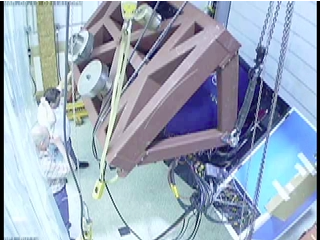Progress on the GPI exoplanet imager integration

this is a test
August 21, 2012
A blast from the past – GPI kick-off science meeting March 2 2007
June 15, 2013The Gemini Planet Imager (GPI) is a next generation adaptive optics instrument being built for the Gemini Observatory. This is an ambitious project with the goal of directly imaging extrasolar planets orbiting nearby stars. The instrument is currently being integrated at the University of California at Santa Cruz. After more than a year of testing in a fixed orientation in a clean room, on March 7, 2013, the 2,030 kg instrument was set up on a crane and flexure rig. In collaboration with the UCSC team, we prepared this time lapse video showing GPI being set up in its new position.

Gemini Planet Imager Flexure Jig Mounting from Franck Marchis on Vimeo.
This new setting is an important step in the integration of GPI, since it will allow astronomers to test the instrument in more realistic conditions. Because GPI will be mounted on the Cassegrain focus of the 8m-class telescope, the 2-ton instrument will move with the telescope. After studying the instrument’s behavior for more than a week, the team is glad to report that the first results are promising and the instrument is stable despite the effect of gravity.
Combining adaptive optics, coronagraphy and spectroscopic capabilities, GPI will be capable of imaging and studying the light coming from Jupiter-sized exoplanets in orbit around nearby young stars. It will also study disks of dust from comet or asteroid belts around those stars, potentially detecting structure caused by even smaller planets. Individual opto-mechanical components of GPI must remain aligned to within 2 microns – 1/10th the diameter of human hair – over the course of an hour-long observation of a target, even as the telescope moves to track stars. The goal of this new set up is to study those effects. After four weeks of testing on the flexure jig and crane, GPI will be moved into a giant refrigerator to show that it can remain operating and aligned even under cold mountain-top conditions.
GPI is one of the major projects in the field of exoplanetary science with the involvement of ~60 researchers from 15 institutions (Lawrence Livermore National Laboratory, University of California, Santa Cruz, University of California, Berkeley , University de Montreal, STSCI, SETI Institute, Herzberg Institute of Astrophysics, American Museum of Natural History, University of California, Los Angeles, Dunlap Institute, Jet Propulsion Laboratory, Arizona State University and University of Georgia.). The instrument is scheduled to be shipped to Chile in the second semester of 2013 and will have its first light shortly after. Until then, the GPI team is making sure that the instrument is properly understood and the data processing pipeline is working fine. There is not a day that goes by that I don’t wonder how many exoplanets we will find with GPI…
Clear Skies,
Franck Marchis
Disclaimer: I am writing this post as the co-lead of the Education and Public Outreach and member of the data analysis and observation team of the GPI Extrasolar Search Campaign (GPIES). I am involved in the GPI project since 2007.




